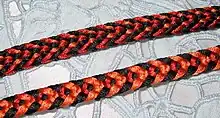

Kumihimo (組み紐) is a traditional Japanese artform of making braids and cords. Literally meaning "gathered threads", kumihimo are made by interlacing reels of yarn, commonly silk, with the use of traditional, specialised looms – either a marudai (丸台, lit. 'round stand') or a takadai (高台) (also known as a kōdai).
There are a number of different styles of kumihimo weaving, which variously create a braided cord ranging from very flat to almost entirely rounded. Kumihimo cords are used as obijime, cords worn belted around the front of some obi when wearing kimono.
History
Kumihimo braids were first created by using fingerloop braiding to weave different yarns together. Later, tools such as the marudai and the takadai were developed, allowing more complex braids to be woven in a shorter amount of time.
In the present day, modern variations of kumihimo weaving discs exist, typically made of firm, dense foam with (typically) 32 notches around the edge, creating the tension necessary for weaving kumihimo. These discs are considered to be a more affordable and portable alternative to a traditional marudai, with many different sizes and shapes of disc available for purchase.
However, a modern foam kumihimo disc is considered less versatile than a traditional marudai. A traditional marudai allows the weaver to use as many yarns of as many thicknesses as desired, and to create braids which are flat, four sided, or hollow. A foam kumihimo disc constrains the weaver to no more than 32 yarns that must not be thicker than the notch allows, and does not enable the creation of flat braids. To make a flat braid a separate rectangular or square "disc" must be made or purchased.
The most prominent historical use of kumihimo was by samurai, as a functional and decorative way to lace their lamellar armour and their horses' armor (barding). Kumihimo cords are now used as ties on haori jackets and as obijime, used to hold some obi knots in place or to decorate the obi when wearing kimono.
Related terms
- Kagami – the top braiding surface on a marudai; Japanese for "mirror".
- Kongō Gumi – a class of patterns for round cord all involving eight threads folded in half for a total of sixteen strands. In clockwise order, each bobbin is moved to the opposite side. When different combinations of thread color are used, many interesting patterns emerge, including diagonal stripes, diamonds on a background, triangles resembling hearts, and tiny six-petalled flowers.
- Marudai or maru dai – the frame for the braiding; maru dai Japanese for "round stand".
- Mizuhiki, decorative cords used to decorate objects such as shūgi-bukuro envelopes.
- Obijime – the broad cloth sash used in traditional dress; a kumihimo belt, called the obijime, is tied around the obi.
- Takadai – a takadai is a large, rectangular frame for creating flat, oblique kumihimo braids.
- Tama – bobbins. The thread is kept from unwinding by passing the thread under itself, forming a loop around the tama. True silk is a hollow fiber with a rough surface that resists slipping past the loop unless gently pulled. For synthetic fibers, a flexible plastic "clamshell" bobbin may be preferable.